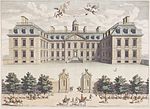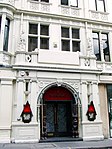Piccadilly Gallery
The Piccadilly Gallery was an art gallery which operated from a number of addresses in London between 1953 and 2007. It was originally founded as the Pilkington Gallery in 1953 by Eve Pilkington and her late husband Godfrey Pilkington, with a focus on exhibiting the works of figurative artists in the styles of Art Nouveau and 19th and 20th Century Symbolism. In 1954 they were joined by Christabel Briggs. In 2007, following the passing of co-founder Godfrey Pilkington, the gallery closed their public store front. The gallery operated from a number of West End addresses, first from bomb-damaged premises in the Piccadilly Arcade, and then on to 16a Cork Street in 1954. In 1978 they moved next door to No.16 Cork Street, and in 1999 the gallery temporarily moved to Dover Street.They promoted the artists Adrian Berg as well as Max Beerbohm, Gwen John, Eric Gill and William Roberts as well as hosting major exhibitions of Gustav Klimt, Egon Schiele and the German Neue Sachlichkeit.Listings of the gallery's exhibitions and correspondences are held by the Tate.
Excerpt from the Wikipedia article Piccadilly Gallery (License: CC BY-SA 3.0, Authors).Piccadilly Gallery
Dover Street, City of Westminster Mayfair
Geographical coordinates (GPS) Address Website Nearby Places Show on map
Geographical coordinates (GPS)
| Latitude | Longitude |
|---|---|
| N 51.5082 ° | E -0.1421 ° |
Address
The Arts Club
Dover Street 40, 40a
W1S 4NH City of Westminster, Mayfair
England, United Kingdom
Open on Google Maps






